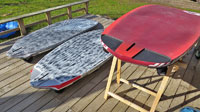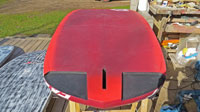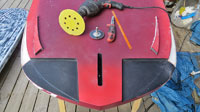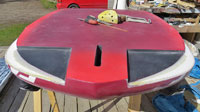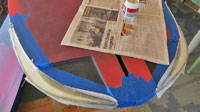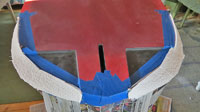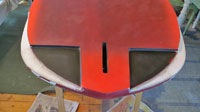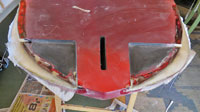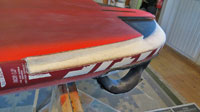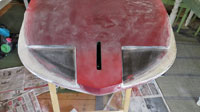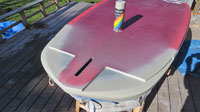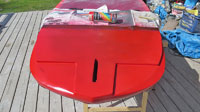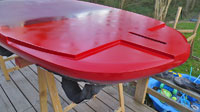April 2015.
An
attempt to modify a Fanatic Falcon 152.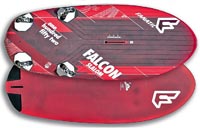
I ordered a Fanatic
Falcon 152 (90 cm wide) in the summer of 2014 to replace a RRD
X-Fire v4 129 (85 cm wide)
that
was handed over to my son.
With the
Falcon 152 I was looking for a little earlier planing board than the X-Fire, that I've been very, very happy with. The sail
used with both boards is a North Warp F2013 9.2,
Due to
an injury I
was not able to sail the Falcon 152 when it arrived (in the autumn
2014), so the
board
didn't
meet the water
until
late winter and early
spring 2015.
It has certainly not been sailed enough to
give me a
firm opinion on its character, but I THINK that I've got a kind of
feeling:
Compared to the
X-Fire 129,
perhaps the Falcon 152 gets a little earlier into planing, or at least
it's not important to be
as active to get
it
into planing. It's a
slightly tricky question,
because you feel a bit more agile on the X-Fire -
an agility that encourages you to be more active in the planing phase.
The Falcon 152 invites you to be a little more lazy.
When planing, the Falcon 152 skims over the water with very little resistance. However, it feels somewhat "dead" and sails very "flat" (level) - yes, I would say it sails surprisingly formula-like (as I recall). Unfortunately, I've not sailed the board close to other sailors, so I haven't got an opinion on how effective it is.
It seems that the
Falcon 152 is pretty controllable with little tendency to raise
its nose or dance on its tail in the gusts. Compared to the magazine
tests of the smaller Falcon boards,
which
have been judged very "lively" (not to say uncontrollable) for the last
several years, this apparent nose-down
controllability came as a surprise to me.
It jibes pretty
formula-like, with a substantial resistance against turning, and you'll
have to be heavy footed when trying to dig the rails into the water at
speed. Because of the width of the board it's not surprising
that you'll have to take a BIG step across the board when jibing, and also as expected
is the tendency to stop totally when flipping the sail (at least for a
sailor at my level).
Inspired
by a test in
the German "surf" magazine, I got hold of a Tabou T-Lab 52 cm G-10 fin
(donated by a windsurf buddy),
that the magazine told is a good compromise between early planing and
speed with a not-too-big sail. Perhaps that's true, but I've
felt that the
board becomes a little bit more lively when sailed with a F-Hot 50 cm
extra soft fin - at least when the wind isn't marginal. However, I'm
pretty convinced that the board will benefit from a somewhat bigger fin.
So, a larger fin of the soft kind is certainly wished for (F-Hot doesn't
produce fins over 52 cm, so perhaps a Sonntag 54 cm fin?).
The trim of the board
feels good, and it's very easy to get into the straps. But in this early
stage I've not yet mastered putting
pressure on the mast foot in a way to free up the board and
be a bit more
exciting (and speedy)
to ride. Perhaps
that's merely a fin issue?
Wishes.
The Falcon 152 is far
from a bad board, but can it be modified a little to meet my
(unrealistic?) requirements a little better? That is, can it be modified
to ...
- sail a little more
free, i.e. sail a little more nose-up (a feeling of sailing higher on
the water)?
-
be a bit more exciting to sail, i.e. change character a little away from the formula-like
towards the more
slalom-like?
- be a little less
resistant against digging the rails in the jibing phase?
- accept a smaller
fin?
- be a little more
"agile" (more
demanding?) in the planing phase?
- be a little "speedier"; from the German test (referred to) I see that the Falcon 152 is judged to be the most explosive board (best
accelerating board) from slugging to planing - but implicitly not the fastest
over a longer distance(?).
And of course all
these wishes without too high costs on other performance
characteristics.
What to modify?
Looking
at the shape of the Falcon 152 you quickly recon that the tail shape is
somewhat old-fashioned compared to slalom boards from other shapers
these days; it seems that the Fanatic shaper, Sebastian Wenzel,
(together with the JP shaper, Werner Gnigler,
by the way)
belongs to
the more traditionalist end of the shaper-continuum. I'm not trying to
evaluate
the shapers or their work (certainly not in a position to do that), but
for the un-trained eye the tail shape of the Falcon is rather
conventional, but clean. So modifying the tail could be the way to go.
Also because it's presumably much easier than to modify other shape
parameters of the board.
Vague assumptions.
Before deciding what
to do, of course some assumptions about the shape of the tails of modern
slalom boards have to be made. And it has to be stressed that it's pure
guessing without knowledge!
1.
The major lift of a
slalom board (or any board)
results from the meeting between
the
water surface and the
bottom of the board.
And
by this I mean at the meeting point only.
In the good old days the Planchemag testing crew measured
the widths of the boards 60 cm from the tail (almost 2 feet off),
indicating that this was approx. the place where the water hits the
bottom at planing speed.
And of course, the wider the bottom of the board at this place
(lets call it the contact point), the more lift.
2.
The area behind the
contact point also produces some lift, but not nearly as much per square
inch as around the contact point. So, the area behind the contact point
gives a little lift, but not that much compared to the friction (drag).
Consequently many board shapers wish to minimise the friction between
water and bottom behind the contact point (at the expense of some lift,
of course) in the search for speed.
3.
Diminishing the
friction between board and bottom behind the contact point can be
achieved in two ways:
a) by giving the
board a little rocker (1 -3 millimetres) towards the tail (tail rocker).
b) by tapering the
plan shape of the bottom behind the contact point.
As to a): Giving the
board a little tail rocker behind the flat section of the bottom is
tricky business, as from empiric experience the board is in imminent
risk of being uncontrollable (but theoretically fast!). Why's that?
Don't know, but PERHAPS:
In a gust we all know
that the nose of the board lifts, pushing the contact point further
backwards. If the board has tail rocker only (i.e. isn't especially
tapered), the new meeting point with the water surface is almost as wide
as the "normal" meeting point, giving almost the same lift as in not so
powered conditions. With an only small reduction of lift as the board
rolls back on its tail in a gust, the sailor is not helped much in
regaining control.
Furthermore, with the
slightly bending away of the tail, it will relatively easily roll back,
without digging the tail as deep in the water as if the board had no
tail rocker. Digging the tail deep in the water in a gust will create a
force to level the board again. But this force is not so powerful on a
board with tail rocker.
Fanatic Falcon medium sized slalom boards are generally known for having a little tail rocker (and a very short flat section and relatively little taper) "for freeing up the boards a little." And in the Planchemag tests the medium sized Falcons are usually characterized as very fasts boards with not-so-good planing ability and lousy control. If you want to play with tail rocker on slalom boards to get the speed without paying on the planing and (not least) control account, maybe the key is to combine the tail rocker with a very long flat. This (a 3 mm tail rocker combined with a very long flat section 25 - 100 cm from the tail) is perhaps what caused the Angulo Magnum 115 slalom board to score maximum mark in early planing and almost maximum marks in control and speed in the 2015 slalom board test in Planchemag?
By the way, measuring the Fanatic Falcon 152, it seems to have around 1 mm tail rocker/kick with the flat section placed aprox. 20 - 85 cm from the tail.
As to b): Tapering
the plan form is another way to go, and from the tests of the magazines
it looks as if the costs on the control account aren't as high as
when
using the tail rocker method.
Especially the
Starboard iSonic series have used this method with great success the last
few years - but others have accompanied the brand.
It seems that the
trick of giving the board a little tail rocker and the trick of tapering
the tail section are difficult to combine - although
apparently the RRD X-Fire series are
designed with both
measures (successfully
so).
4.
So, if you want speed
without the cost (lack of control and late planing), the tapered tail
mean seems to be the
easier
way to go. And apparently modern thinking is that
it's more effective to have a "stepped" tapering than just a pin tail.
Perhaps it's because a pin tail creates a little more drag along the
rails compared to a stepped tapering - that is a tapering with
"spoilers" along the rails. The classic "cut outs" around the fin box is
one way of tapering with spoilers, and the re-invented "wingers" is
another. Modern slalom boards (Starboard iSonics, RRD X-Fires, Tabou
Mantas and more) use both wingers and cut outs to drastically taper the
tails. The wingers are mostly placed approx. in the middle between the
front and the back straps - and of course behind the water/bottom
contact point.
Before Starboard
began step tapering their slalom boards (starting with the iSonic 110,
I think) they were renowned for
designing very controllable -
but somewhat sticky slalom
boards. The sticky issue seems to have disappeared after the
introduction of the stepped tapering tail. Now the iSonics - according
to the tests - are sailing
somewhat free and
higher on the water than
before, although not quite
as free as a couple of the competitors. And they're still more controllable than most.
PWA sailor Sean O'Brian says about "... the idea of the reduced tail areas with the 'wings' over the back foot area. Everyone is going this way and I'm glad... It's simply the best thing that's happened in slalom board design in recent years! We get such an increased wind range out of the boards now... Much bigger tail widths under your feet to push against but much smaller tail widths on the water to keep control at high speeds and gives you a ton more comfort and tighter turns in the gybes. You really notice it if you step back on to a board from 2 seasons ago without it ..." (http://www.seabreeze.com.au/forums/Windsurfing/Review/Starboard-iSonics-2015/?page=3).
Along with the
freeing up of the boards the step tapered tail also seems
to be accompanied with the need for smaller fins. As an example, until
this winter I rode a RRD X-Fire v4 114 (with a first generation step
tapered tail) with a 7.8 sail using a 40 cm F-Hot fin. After having
substituted the X-Fire 114 v4 with a Tabou Manta 71 with a VERY step
tapered tail, I sail with the same 7.8 sail using a 38 cm Hurricane
Downwind fin. I still use the 40 cm F-Hot fin
these days,
but then the Manta is equipped with my 8.6 sail. This indicates that the more step
tapered tail, the more room for using
a smaller fin. I think.
Why's that? Is it
because the rails of a narrower tail better accept "flying" the fin -
that is the leeward rail doesn't try to level the board
sideways
as much and
thereby gives the fin possibility to work with more pressure and in a
more favourable angle (with the tip bent a little towards windward)?
5.
Starboard
says
about the new (2015) iSonics that "... secondary wingers are closed off
on the deck side, eliminating the full step that can crack under
exceptional stress." Behind this somewhat cryptic description I guess hides that
the overhang between the wingers cut out and the deck around the back
foot pads is stronger if it slants out towards the rails. If not,
there seems to be a risk that the weight from the heels will crack the
wingers. A slant
support of the deck under the pads is stronger than a horizontal
overhang.
Don't know if this is
understood right, but if digging out material to wingers, no harm is done
by slanting the overhang of the wingers. Just in case.
6.
Shape of the cut
outs: The cut outs of
the
Falcon 152 - and the
cut outs of several slalom boards from other companies - are not quite
open at the rails. The rails are extended a little backwards and kind of
form a little barrier between the water surrounding the board and the
cut outs. In the case of the Falcon 152 the rails are extended about 2
cm, and for other slalom boards with this feature it's often shorter.
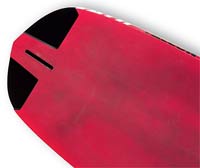
I'm not sure what's
the point with this special cut out design. I THINK there's a tendency
that you see the design more often and it is more dominant with bigger
slalom boards, so perhaps it has to do with the much talked about "grip"
of the leeward rail?
I think this grip thing is nonsense (unless the rails in the tail are almost parallel), and that it distracts from the real thing (the flex and thereby lift of a bending fin when tilting the board a little to leeward). Neither the Tabou Manta series nor the RRD X-Fire series have the extended rails - even in their biggest boards - and I see no reason to copy it in the modification below. But perhaps I'll get wiser?
The
modification.
From the words above it probably comes a no surprise, that what you'll se in the pictures below, is an attempt to incorporate some "wingers" in the tail shape of the Falcon 152. I'll not try to come up with some fancy statements on the exact shape. Let's just say that shape and cutting job is based on the intuition of an ignorant.
The Fanatic Falcon 152 lies ready on the operating table. A RRD X-Fire 129 v4 and a Tabou Manta 71 are lined up for inspiration.
Click the picture to enlarge.
Last view of the original tail shape. Some pencil strokes mark what's gonna happen.
Click the picture to enlarge.
Some material is cut away to form the "wingers".
Click the picture to enlarge.
The wingers overhang (the separation between wingers and deck) and a little of the cut outs are "slanted".
Click the picture to enlarge.
Glass weave wetted with epoxy resin is laminated to the area.
Click the picture to enlarge.
A sandwich layer is laminated to the glass weave layer with epoxy resin.
If you're lazy, you could probably avoid this sandwich thing and just laminate some extra layers of glass weave instead(?).
Click the picture to enlarge.
The sandwich material is cured and sanded into shape - ready for the outer layer of glass weave/epoxy resin.
Click the picture to enlarge.
The outer (and final) layer of glass weave/epoxy resin is in place.
Click the picture to enlarge.
The epoxy is cured, and the area is sanded - ready for the final finishing.
Click the picture to enlarge.
A little filler (epoxy with filler powder - or just polyester filler from a can) is added to smooth everything out. Now ready to be wet sanded.
Click the picture to enlarge.
A little filler spray is added to fill the last almost microscopic holes.
Click the picture to enlarge.
The area is spray painted with auto spray.
No, I'm not colour blind, and when I get hold of the right colour, the area will probably be re-painted!
Click the picture to enlarge.
The area is covered with a thin layer of transparant auto spray to level out the transition between the painted and non-painted (the original) areas.
The last thing that needs to be done, is to wet sand the area with very fine grained sand paper.
Click the picture to enlarge.
A warning before reading the verdict.
I haven't tried the modified beast yet, but as soons as I've got a qualified opinion, I'll let you know.
In the meantime it's appropriate to state some reservations: Trying/testing a board on the water is a rather subjective "science", where you're under influence from a lot of irrelevant feelings, moods etc. In this case my verdict is in imminent danger of being biased from the fact, that I very, very much wish for the modification to be a success. If not for my personal pride, then at least because a total failure will diminish the value of a 2.000 Euro board to a zero value board. Please keep this in mind!
May 2015.
Verdict - did the modifications work as intended?
First impressions:
First of all, the
surgery of the board have
produced no flaws. That is, the board has come up with no negative
surprises - except perhaps a feeling that some of my windsurf buddies is
suppressing some laughing behind my back because of the insanity of the
project. Only one way to change that!
With reference to the
wish list the interim feelings are:
The board is
definitely sailing a bit more free, and especially it's easier to keep
the nose up and free of the back of
the chop when going downwind at speed. Of course, it hasn't
developed to a freeride board in this respect, but now it's more in line
with my smaller slalom boards and has distanced the taste of formula
board.
I just received a new
fin for the board - a 55 cm Sonntag SL-P r3 that I've not tried yet. I
ordered the fin (with very friendly guidance from Alexandra & Joerg
Sonntag) before having tried the modified Falcon 152, and frankly now
I'm a little worried that the fin will show to be a bit big. The
modified Falcon 152 has solely been tried with a 50 cm F-Hot fin - a fin
that with the original Falcon 152 shape felt a little too small, but
also a fin that now feel almost big enough with my Warp F2013 9.2. With
my Warp F2012 8.6 the 50 cm F-Hot fin feels spot on.
The fact is that I
think that the modified Falcon 152 has decreased the demand for a
powerful fin. If that's caused directly from the new tail shape, or it's
caused in a more indirectly manner - for instance because of generally a
little more speed, producing more lift from the fin - I don't know.
Anyway, I certainly look forward to try the (extremely well
manufactured!) Sonntag fin, but with a bit of nervousness.
One of the most
obvious differences between the original and the modified shape is that
the initiation of the jibes is a lot easier. The less need for really
pressing the leeward rail and pulling the windward strap is very
pronounced, and consequently smaller arcs is now possible - without the
board loosing more momentum for that reason. The modified Falcon 152 is
definitely still a lot heavier in the jibes than a smaller slalom board,
but the formula taste has gone.
I haven't been able
to detect any difference in early planing - either actively or
passively. But perhaps no news in this respect is good news.
Update October 2015:
A trim problem that was probably not caused by the tail modification.
In my place we've
had at lot of winds this summer, and consequently I've had difficulty in
trimming my tail-modified Falcon 152 in a systematic way. However, now
the trimming seems to have come to an end, and finally I'm satisfied
with the behaviour and performance of the board. Forgive me if these
words seem unnecessary detailed - except
perhaps
for windsurfers facing similar
trim problems.
Originally the my
Falcon 152 was destined to be used with my North Warp 2013 9.2, and the
trimming process was somewhat mudded as I was forced to change sail. The
fact is that my Platinum 2013 490 cm mast broke, and when receiving the
replacement Platinum 2015 490 cm mast the change in bend curve (2 points
more Flex Top) turned out to make the mast incompatible with the sail.
Surprisingly, it was simply impossible to keep the lower camber attached
to the mast. Consequently I had to get a replacement sail.
Race sails from a
lot of brands (including North) have to be ordered pre-season these
days, and there was no way to have a substitute newer Warp mid-season.
To my knowledge a very few other brands have stock race sails, ready
to ship on demand and
that narrowed the options substantially.
It's a well known
"secret" that the race sails
from Gun match the masts from North - yes, in
fact the Gun Select 100% masts (from Italica, just like the North
Platinum masts) even moved in the extreme Flex Top direction a couple of
years before North also realized that they had to do the same, in order
to bring the Platinum masts breaking tragedy to an end. So in all,
the cheapest way to get a
replacement sail - without also having to invest in a new mast - was to
ask Gun to send me a GS-R 2015 9.5. And as expected the GS-R could be
rigged with the Platinum 2015 490 cm mast without any problems.
From the few
sessions with the North Warp 9.2 I had got the interim impression that
the Falcon rides somewhat nose-down (certainly bettered somewhat
by
the tail modification), and that there's a lot of pressure on the back
foot, letting the front foot hang pretty loose in the strap. That
trimming issue only got worse with the GS-R 9.5. Now it really was a
pain to keep the front foot in place. The sailing got very tiring, and
it was almost impossible to get some mast foot pressure. I simply felt
that the draft of the sail was placed too close to the tail of the
board.
To complicate the
matter further, the very loose front foot was obvious on both tacks -
but clearly worst on
the
starboard tack. For the time being I decided that
that was a result of my body not being quite "symmetrical".
To fix the problem a
lot of means were tried out:
- The straps in the
rear plugs.
- Mast base forward
- but of course not so much that the foot of the sail would rub the deck
of the board (this
issue certainly isn't helped by the "depressed mast track fashion"
of the Falcon 152
(and many other slalom boards) these years ...).
In fact I came to
wonder, if placing the mast base more forward also place the draft of
the
sail more forward at
all. Generally, often I feel that a more forward placement of the mast
foot results in a
more raked sail - so that the draft creeps backward. Contrary to the
effect
wished for!
- Lowering the boom
- but not so much that the board became "sticky".
- Longer harness
lines to produce a more horizontal push on the rails of the board.
- Tightening the
straps, forcing the feet further out on the rails.
- Placing wedges
under the front pads to "secure" the feet in the straps (the
board is born with
wedges under the
rear pads).
Still, the extreme
pressure of the rear foot/looseness of the front foot was only partly
diminished. To further fix the problem I could either modify the sail
(sail with too much outhaul or stiffen up the back of the sail with some
extra battens - all to force the draft further forward). Or I could
modify the board by placing new plugs behind the existing ones (placing
my body further back and more in line with the draft of the sail).
I chose to insert
new plugs 2 cm closer to the tail and a tiny bit further outboard. And
that helped a lot! Still I have to place the boom 4 cm lower than when
using my latest big slalom board (a 85 cm wide RRD X-Fire 129), but it
was the placement of new plugs that finally solved the problem.
So, probably due to a combination of the cut out/winger modification and the new rear plugs my Falcon 152 now sail much more like my current and past slalom boards. It sails free (and fun) without being on the edge of being airborne, it doesn't stick on the back of the chop when going downwind, and the balance between front and rear foot is OK. The performance is fine with very early planing and relatively good speed - especially in moderate winds. I now use a Sonntag 55 cm fin in the light and moderate stuff, and a F-Hot 50 cm fin in the upper wind span.
The only (academic)
question that bothers me is: Was the problem getting in line with the
draft of the sail caused by the Gun GS-R 9.5 sail, was it caused by the
cut out/winger modification of the board, or was it caused by
relatively forward strap
placement of the original board?
- I haven't got the fantasy to imagine how the tail modification should result in this kind of a trim problem, so I'm disposed to believe
that it's a matter of a
backward draft of the Gun GS-R 9.5 sail and/or a forward placement of
plugs on the Falcon 152.
- As to the sail, I've discussed the issue with a windsurf buddy who happens to sail the same sail (a Gun GS-R 9.5 2015). And funny,
although sailing a different board (a Tabou Speedster 89) he has also had problems keeping his front foot in the strap - but only
on the starboard tack! Remember I said that my problem was worst on starboard tack? Does the Gun GS-R 9.5 2015 (and perhaps
other sizes too?) have an issue not being total symmetrical, so that on starboard tack the draft moves backward compared to
port tack?
- As to the board, perhaps the Falcon 152 isn't designed as a full blown slalom board (being too wide for competition), and perhaps
the presumed relatively recreational nature of the board has dictated a more forward plug placement? Compared to the
"legitimate" Falcon slalom boards and the Falcon Formula, the Falcon 152 might look as if the straps have been placed relatively
far forward. At least so it seems.
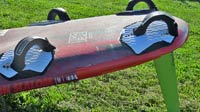
The new strap positions, made
possible with new plugs behind
the original ones.
Click the picture to enlarge.
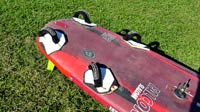
With the new strap positions the
homemade wedges have become
useless.
Click the picture to enlarge.
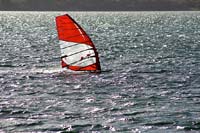
Snapshot of the trim in light/
moderate conditions. Gun
GS-R 9.5 2015 sail, Sonntag
SL-P r3 55 cm fin.
(Courtesy Marianne Gersner).
Click the picture to enlarge.
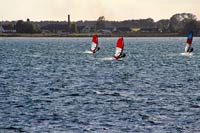
Snapshot of the trim in heavy
wind. GS-R 9.5 sail, Sonntag
55 cm fin. To the left my
windsurf buddy with a similar
sail, same board size (different
brand) and 58 cm Sonntag fin.
(Courtesy Marianne Gersner).
Click the picture to enlarge.
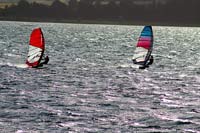
Snapshot of the trim in heavy
wind. GS-R 9.5 sail, F-Hot 50 cm
fin.
(Courtesy Marianne Gersner).
Click the picture to enlarge.
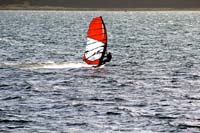
Snapshot of the trim in heavy
wind. GS-R 9.5 sail. F.Hot 50 cm
fin.
(Courtesy Marianne Gersner).
Click the picture to enlarge.
DIY - nothing
to be afraid of.
When you look at the
very different tail shapes of current and old slalom boards - different
between the brands and different within the brands - you're left with
the impression that the design/shaping work is based at least as much on
feel and "lets try this" as
on a more "scientific" approach.
Some designers tell
they have a huge archive of shape data and templates, and this probably
help them to have some structure in their work. However, the variety of
shapes - some of them
almost running through a cycle (invented - forgotten - re-invented ...),
and some of them resulting in almost identical performance although
looking very different - indicate that board designing is far from being
an exact science.
In consequence, I
think that you don't have to be afraid of modifying the tails of your
boards yourself. I mean, looking at our boards - and linking the shapes
to the experienced performance - most of us have a fairly good idea how
different tail shapes influence the performance. And the distance from
this more or less intuitive insight to start cutting and adding
material to your boards isn't
that long. Have fun!
Finally: Below is a
picture of the new Falcon 99 2016. Of course,
the similarity in tail shape between my modified, old Falcon 152 and the
new Falcon 99 is a coincidence, but funny anyway.
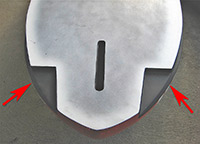
Click the picture to enlarge.
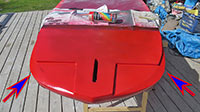
Click the picture to enlarge.
... and to the right you'll see a picture of
the tail of the successor - the Fanatic Falcon Lightwind 2017 (159 l).
The picture's grapped from a thread in https://www.seabreeze.com.au.
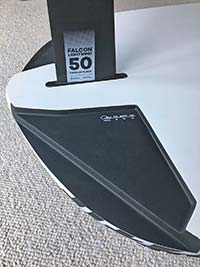
Click the picture to enlarge.
